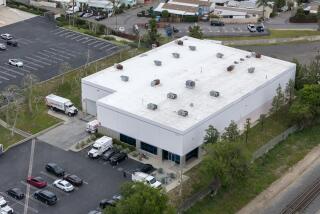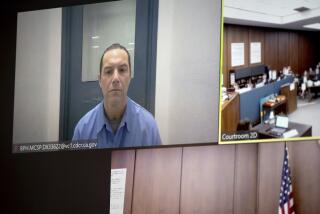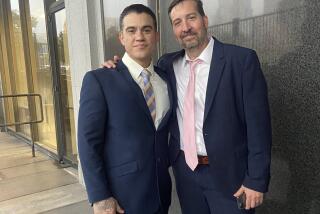FBI Will Examine Lisker Case
The Los Angeles Police Department has asked the FBI to examine crime-scene evidence in a 22-year-old murder case that casts doubt on the guilt of the man convicted of the crime, police said Thursday.
The decision to seek FBI assistance comes after an article in The Times last month detailed findings that contradict the LAPD’s case against Bruce Lisker, 39, who is serving a life sentence for murdering his mother, Dorka, in the family’s Sherman Oaks home in March 1983.
Police officials want the FBI to focus on two footprints from the crime scene that an LAPD analyst now believes were not Lisker’s.
If the FBI backs up the finding that the footprints were not his, the department should reinvestigate the case, David Cunningham III, president of the Los Angeles Police Commission, said Thursday.
“I find the footprint evidence very troubling,” he said.
Police officials acknowledge that the original investigation of the murder was deficient, but say they still believe Lisker was guilty and have no further plans to investigate the case further unless ordered to.
“An innocent man is not in prison,” said Deputy Chief Gary Brennan. “If we thought there was, we would continue to press forward in the interest of justice.”
Cunningham said he wanted detectives to brief commissioners on the status of the probe.
“When it appears that there is new evidence, and you’re talking about a homicide, and you arguably could have an innocent person behind bars, I think that deserves another look,” Cunningham said. “It warrants further investigation.”
One of the bloody footprints in question was found in a bathroom of the family home. At Lisker’s trial, the jury was told that it was his, but a department analyst now says it was not made by his shoes. The police analyst also examined an autopsy photo that showed the impression of a shoe on the victim’s head. The analyst determined that it, too, was not made by Lisker’s shoes, but was “similar in size and dimension” to the mystery footprint in the bathroom.
Vicki Podberesky, an attorney for Lisker, called the footprint evidence “the most critical piece of evidence” in favor of her client’s effort to win a new trial.
“I don’t know why the LAPD feels the need to verify the findings of one of their own analysts,” she said. If the FBI’s findings are less conclusive than the LAPD’s results, it could lead to an odd court battle where the LAPD would be trying to discredit their own in-house expert, she said.
William J. Genego, another Lisker attorney, said “it’s unfortunate that [the LAPD] didn’t give the same kind of scrutiny to the evidence that incriminated Bruce that they are now giving to the evidence that exonerates him.”
Nonetheless, Genego said he welcomed the additional review “as long as they are not shopping for a different conclusion and are looking for the truth. We’re confident that it will exonerate Bruce.”
Police Commissioner Alan Skobin said he supported the department’s desire to “look for a second opinion.”
“This should not be interpreted as a lack of confidence in the analyst,” he said. “I think it’s a positive thing.”
The Times’ seven-month investigation of the case prompted the man who prosecuted Lisker to say he now has “reasonable doubt” about Lisker’s guilt. Seven jurors have now said they would have acquitted Lisker had they known at the trial about the new evidence.
Brennan acknowledged there were “deficiencies” with the original investigation in 1983. Nonetheless, he said there was significant evidence pointing toward Lisker’s guilt. He said he believed the department’s limited resources would be better spent investigating unsolved crimes and that Lisker’s guilt or innocence should be left to the courts to determine as they consider Lisker’s appeals.
Cunningham said he understood that LAPD resources were tight, “but in a case like this you go out and find the resources to provide justice . We just can’t sit back.”
Cunningham said he wanted LAPD detectives to look at all the evidence in the case, not simply at evidence pertaining to Lisker’s guilt.
In addition to the evidence of the bloody footprint and shoe impression, there is compelling evidence regarding another suspect who was either overlooked by, or unknown to, LAPD detectives.
That alternative suspect, John Michael Ryan, who killed himself in 1996, gave false information about his whereabouts at the time of the killing, had a history of violence and left town the day after the murder. A telephone call from the Lisker home around the time of the slaying was made to a number nearly identical to that of Ryan’s mother — a call that the prosecutor now acknowledges could link Ryan to the crime.
On March 10, 1983, there was good reason to suspect that Lisker — then 17 — might have committed the crime. He had a history of drug abuse and fighting with his mother. His parents paid for him to live in a $210 studio apartment several miles from the family home.
According to Lisker, on the day his 66-year-old mother was killed, he went to his parents’ home to borrow a jack so he could fix his car. While there, he said, he looked through windows at the back of the house and saw his mother lying on the floor. Lisker said he broke in through a kitchen window to tend to her. Though she was still alive, she had been badly beaten with an exercise bar and a trophy and then stabbed in the back with two steak knives. He called for paramedics.
The detective in the case, Andrew R. Monsue, didn’t believe Lisker’s story and arrested him that afternoon for the crime.
Lisker was convicted in 1985 and sentenced to 16 years to life.
His conviction was based, in part, on the testimony of a jailhouse informant who claimed Lisker confessed to him as the two spoke through a hole in the wall between their cells in the Los Angeles County Jail. According to the informant, Lisker killed his mother after she caught him stealing money from her purse.
Lisker has twice confessed to the killing over the years — once in an effort to get a more lenient sentence and later when he became eligible for parole. He now says the confessions were desperate attempts to minimize his time behind bars for a crime he didn’t commit. He has maintained his innocence for more than a decade.
More to Read
Start your day right
Sign up for Essential California for news, features and recommendations from the L.A. Times and beyond in your inbox six days a week.
You may occasionally receive promotional content from the Los Angeles Times.







